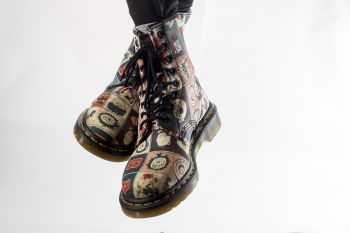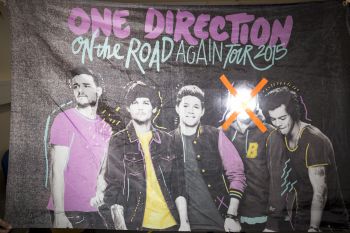In the first of a series of blogs, researchers Rachel Thomson and Liam Berriman reflect on how hackathons might be used as a participatory methodology that span the digital humanities, social science, design and computing.
Talk to me.
Rachel Thomson
On Saturday 14th November I had the pleasure of taking part in an event billed as a ‘Hackathon’ hosted by the Sussex Humanities Lab, CIRCY and the Mass Observation Archive. Hackathons are ‘events in which computer programmers and others involved in software development and hardware development, including graphic designers, interface designers and project managers, collaborate intensively on software projects’.
The day was called ‘my object stories’ and the shared project was to explore ways in which we could bring to life young people’s stories about favourite everyday objects – building on work that we have been doing as part of the Curating Childhoods project which is creating a new multi-media collection within Mass Observation called ’Everyday Childhoods’. The shared task was to invent strategies through which everyday objects – cherished by young people – might talk to an audience and enrich the archive. This might be a pair of Dr Martens boots, a book, a guitar, plastic animals….
Often projects are done in separate stages, with people responsible for their ‘bit’. The hackathon model brought together all the different actors involved in the lifecycle of a research and development project to see what we could get done in a day. In this way, the event created a live interface between processes of data collection, archiving and animation.
The day started and ended with the archive. Young people brought in cherished objects to share as windows into their everyday lives. Researchers and archive outreach officers worked with them to brainstorm what they might want to say about their objects. Photographer Crispin Hughes then collaborated with them to design still images that captured their object, and film maker Susi Arnott recorded them talking about their object’s value and personal meaning.
The digital data was then sent downstairs into the lab where they were used as raw materials for three different data animation strategies. Ben Jackson and Cathy Grundy brought images and sound together within a augmented reality environment – creating short animated films. Manuel Cruz used Unity game design software to make simple games through which a player could encounter objects and stories as part of game pl ay. Chris Kiefer and Thanos Liontiris used motion tracking technology (cameras trained on a fiducial) hooked up to two different platforms: supercollider, through which sound could be triggered by movement, and a second platform which managed visual data projected onto a table acting as a screen. This meant that the object could be moved through a space – with the movements used to reveal images and sound. Young people came down and worked on shaping the three different versions of their object stories.
ay. Chris Kiefer and Thanos Liontiris used motion tracking technology (cameras trained on a fiducial) hooked up to two different platforms: supercollider, through which sound could be triggered by movement, and a second platform which managed visual data projected onto a table acting as a screen. This meant that the object could be moved through a space – with the movements used to reveal images and sound. Young people came down and worked on shaping the three different versions of their object stories.
What I liked most about the day was the way in which all the different ‘experts’ involved got to check out what each other do. I was probably very annoying, looking over shoulders, interrupting and asking questions and no doubt slowed things down. In a day we managed to get a lot done, though nothing ‘finished’. However we did manage to imagine three different ways in which the ‘show and tell’ of research might be achieved in collaboration with digital design. Each of the strategies could provide an interface through which archived data could be accessed and mediated.
The archivists had a think about how the audio and visual data might be cataloged in the archive and spoke with the developers and the researchers about how their different approaches to organising the material might relate. We also gained insight into the kind of work that might be involved in each of the strategies for animation, providing insights for costing future projects. 
The day formed part of an ESRC festival of social science, showcasing to the public the relevance and potential of social research. Our aim was to open up the process through which researchers may co-produce ‘data’ with young participants and to explore the way in which this might be re-used and brought to life in different ways. Building on our earlier work with Mass Observation we wanted to show that an archive need not be seen as a dusty and distant place, but rather the starting point for a range of creative engagements. What is brilliant about the Mass Observation Archive is that it celebrates the mundane and the everyday, believing that in ten, fifty, one-hundred years time people will be as fascinated by hearing about a pair of Dr Marten boots – as we are now excited to know about what people had in their wardrobes in 1945. But the hackathon helped us glimpse how we might use this material right here and now as a starting point in creative experiments with ‘data’.
Hackathons as participatory methodology?
Liam Berriman
Hackathons have become an increasingly commonplace methodology for exploring and experimenting with data. Recent examples of this trend have included calls from archives for programmers and software developers to come and ‘hack’ their collections, and the growth of competitions where young people are invited to play with open-access datasets. Bridging these events is a growing sense of hackathons as a space for playing with archives and data.
 The ‘My Object Stories’ workshop was my first experience of organising (and taking part in!) a hackathon. Over the past year, I’ve become interested in hackathons as a methodology for engaging young people with their own research data – providing a creative space for playing with the re-animation (or ‘hacking’) of data (McGeeney, 2014). Hackathons are often billed as collaborative events that draw on the participation and collective skills of all involved, and i’ve been curious about how hackathons might be used to engage young people in research beyond the data collection process.
The ‘My Object Stories’ workshop was my first experience of organising (and taking part in!) a hackathon. Over the past year, I’ve become interested in hackathons as a methodology for engaging young people with their own research data – providing a creative space for playing with the re-animation (or ‘hacking’) of data (McGeeney, 2014). Hackathons are often billed as collaborative events that draw on the participation and collective skills of all involved, and i’ve been curious about how hackathons might be used to engage young people in research beyond the data collection process.
Though excited by the creative possibilities that hackathons open up, I’ve remained cautious about overstating their potential as ‘participatory’ methods. In past research I’ve voiced scepticism about co-design practices with young people that claim to be participatory. My main concern being that researchers and designers have become very good at speaking the discourse of participation, but are often uncritical about participation’s potential ‘unevenness’ in practice (Berriman, 2014). As such, I approached this event as an experiment in data collection and re-animation, but also as an event in need of critical reflection.

In many ways our hackathon was atypical in format, with the young people creating the data to be ‘hacked’. This created an intensely personal connection between the young people and the hackathon data, with each participant principally concerned with hacking their own data. One of the main challenges this raised was in terms of equipping each young person with the skills and resources to ‘make something’ of their data. Our adult hacker team were on hand to help guide participants through possible data re-animation techniques of varying complexity (ranging from free app tools to game design engines.) The hackathon’s collective expertise and interests therefore played a significant role in defining the potential scope of data animation activities.
The hackathon is therefore a highly situated event that is contingent upon the collaborative pooling of expertise around a common project. Participation is characterised less by unbridled creativity, and more by a curiosity to explore what was possible in a space of assorted interests and expertise. In this respect, the hackathon provides us with a method for engineering collaborative spaces where people with different skills and expertise can come together to experiment with new ways of playing with data.
To find out more about the My Object Stories Hackathon, contact Liam Berriman (l.j.berriman@sussex.ac.uk)
The My Object Stories Hackathon was co-hosted by the Sussex Humanities Lab, the Mass Observation Archive, and the Centre for Innovation and Research in Childhood and Youth. It was funded with support from the ESRC Festival of Social Science and the EPSRC Cultures and Communities Network +.
Liam Berriman December 11th, 2015
Posted In: Uncategorized
Tags: archive, everyday, Favourite things, hackathon, Liam Berriman, Mass Observation, object stories, Rachel Thomson, Sussex Humanities Lab
